 |
|
We
got to Rome at about noon on Monday, and we were ready to eat. We
stopped in a small restaurant near the hotel, and, of course the food was
great. Many courses and free tastes from the waiter. |
|
|
|
 |
|
This was the view from our hotel room, the Bristol Bernini. Bernini
Square was outside the window (no surprise if you read the hotel name) |
|
|
|
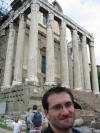 |
|
We
immediately hit the sites and enrolled in a tour of the Forum and the
Coliseum. Our guide was a retired professor and was very
knowledgeable. They are still excavating the forum. If you look
at the building in the picture to the left, the dirt used to be up to the
little black door behind the columns. About 150 years ago, someone got
curious as to where the columns went and POOF, we had a tourist attraction. |
|
|
|
 |
|
Here we are at the Coliseum, one of the symbols of Rome. It is mostly
stripped of the marble exterior and is almost entirely brick on the inside.
The Romans had the habit of tearing down older buildings as a way of
sourcing marble for new ones. |
| |
|
|
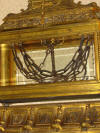 |
|
At
the Church of St. Peter in Chains, you can find the shackles (reportedly)
used on St. Peter. I can't remember what St. P got picked up for, but
I am pretty sure Christ got him off. |
| |
|
|
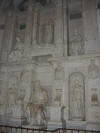 |
|
Also in the Church of St. Peter in Chains is the Michelangelo masterpiece
Moses. When you go, you need to pay 50 cents to turn the light on so
you can see the statue. Clever fundraising by the church. |
| |
|
|
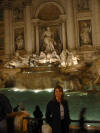 |
|
Here is Julie in front of the Trevi Fountain. It is a depiction of
Neptune riding a chariot pulled by dolphins. It's very Vegas,
especially when lighted at night. You could imagine you were out front
of the Bellagio. For the Hillary Duff fans out there, you probably
recognize this from scenes in The Lizzie McGuire Movie. |
| |
|
|
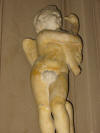 |
|
Well, judging by the strategic placement of the leaf, we must be in the
Vatican (Day 2). The church acquired a huge collection of art that is
housed at the Vatican Museum. All the sculptures were modified with
modest leaves to make them more church ready. |
| |
|
|
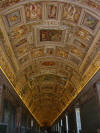 |
|
In
the museum, there are these long hallways with ceilings covered with
artwork. The sheer volume of artwork is amazing. |
| |
|
|
 |
|
Taking pictures in the Sistine Chapel is prohibited. So what you see
to the left is a recreation I made in Paintbrush of what it would look like
of I snuck a quick photo under the Creation of Man portion of the chapel
ceiling. |
| |
|
|
 |
|
Also, do to the prohibition on photography, here is a recreation using clip
art and PowerPoint of what the Last Judgment would look like had I taken a
quick photo without detection. |
| |
|
|
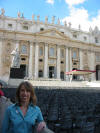 |
|
Julie at the Vatican. This is the seating for where the Pope leads
mass. |
| |
|
|
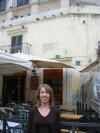 |
|
Day
3: Julie at Campo di Fiore. Not the restaurant, but the actual place
(look at the plaque on the building behind her). Campo di Fiore is an
outdoor market with fresh produce, fish , etc. Its kind of like
Haymarket in Boston, but classier. |
| |
|
|
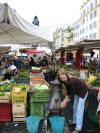 |
|
Again, Julie at Campo di Fiore, continuing towards her dream of eating a
peach on each of the world's continents. The have these taps to
underwater springs around the market so you can wash your produce. |
| |
|
|
 |
|
Day
4: We are on the boat and have awoken in Sorrento. With the exception
of one day, we woke up in a different port each day. |
| |
|
|
 |
|
A
short bus ride from Sorrento is Pompeii. You can't imagine the size of
the place until you see it. I is literally an entire city that once
held 20,000 residents that was buried by a volcano about 80 years before the
birth of Christ. The volcanic residue preserved the entire city,
including the buildings, the people and even the food the people were
eating. |
| |
|
|
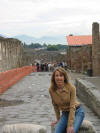 |
|
Julie posing on one of Pompeii's streets. Everything is amazingly
preserved. |
| |
|
|
 |
|
Hopefully, this gives you a sense of how big the place is. You can
tour marketplaces, residential neighborhoods, and common areas. The
only parts missing are the roofs, which were made of wood and burned in the
eruption. |
| |
|
|
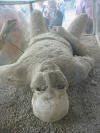 |
|
Here is a guy who looks like he was caught napping in the eruption.
The ash formed a cast around the body, which decayed over time. An
archeologist figured out that if you inject the cast with plaster, you can
recreate the shape of the person, which is what you see here. There
are casts of families, pets, just about everything. Most of it has
left Pompeii, though, and not resides in a museum in Milan. |
| |
|
|
 |
|
Day
5: Sardinia. The place was closed for the winter. We spend a
couple of hours at a posh resort sipping coffee and enjoying the scenery.
As luck would have it, we struck up conversation with a fellow cruiser, and
she turned out to be the mother of one of Julie's former co-workers.
As Steven Wright says, "It's a small world, but I wouldn't want to have to
paint it." |
| |
|
|
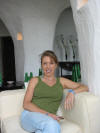 |
|
Here is Julie in the lobby lounge of the resort. |
| |
|
|
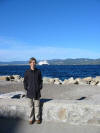 |
|
Day
6: On to St. Tropez. Off in distance are the Alps. As you can
tell, it was a bit chilly, but we didn't mind. The place was
pleasantly empty. It must be a nightmare when at full capacity. |
|
|
|
 |
|
Here is a picture of the harbor take from a fort on top of a hill in the
center of St. Tropez. Off in the distance you can see our ship. |
| |
|
|
 |
|
Most of the day was spend shopping, evidenced here by the collection of
bags. |
| |
|
|
 |
|
Day
7: A day at sea. We spend the day lounging in the room (Julie) and
playing poker (Bill). Each cabin on the ship had a private veranda.
This is the view from our private deck. |
| |
|
|
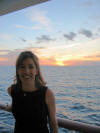 |
|
Here is Julie taking in the sunset before we went to the Cruise's formal
dinner evening. |
| |
|
|
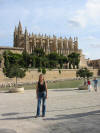 |
|
Day
8: Palma de Mallorca. Here is Julie outside the cathedral in Palma,
the port city in Mallorca. |
| |
|
|
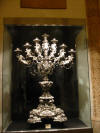 |
|
In
the church are a number of relics, including a matched set of giant
candlesticks. Each one weighs 2,000 pounds. Liberace, eat your
heart out. |
| |
|
|
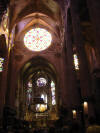 |
|
The
church also holds the largest rose window in the world. It something
like 70 feet across. |
| |
|
|
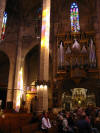 |
|
When the light shines through the rose window, the chapel is illuminated in
kaleidoscope-like color patterns. |
| |
|
|
 |
|
Day
9: We make it to Barcelona. What a beautiful city. Wish we hade
more than four hours there.... |
| |
|
|
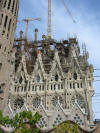 |
|
The
artist and architect Gaudi has his work all over the city. he is known
for his over the top designs and is the inspiration for the English work
"gaudy". This is a church he designed that they started building 200
years ago. They expect it will be done in 2029. It looks like
something out of Walt Disney. |
| |
|
|
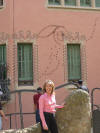 |
|
Gaudi also designed Parc Guell. Parc Guell was kind of like the Castle
Pines of Barcelona. It was intended to be a well planned housing
development for the very wealthy. Unlike Castle Pines, no one every
moved there. Here is Julie standing in front of the model home, one of
only two homes on the entire place. The other home was one built by
the developer. After the developer's death, his family sold the
property to the city to avoid the ongoing property taxes. |
| |
|
|
 |
|
All
the roads in Parc Guell were elevated, so cars could travel on top, while
pedestrians strolled underneath. The natural rock designs you see here
are consistent throughout. |
| |
|
|
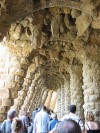 |
|
Here is a shot of the pedestrian walkway underneath. |
| |
|
|
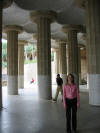 |
|
Gaudi designed an outdoor market area. To make it look interesting, we
designed the columns so the all stood at slight angles. While
structurally sound, prospective residents believed it would topple.
Gaudi was truly ahead of his time. |
| |
|
|
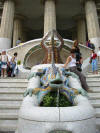 |
|
At
the front gate of Parc Guell is a giant salamander, the symbol of the park. |
| |
|
|
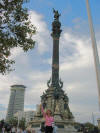 |
|
At
the edge of the harbor of Barcelona is their signature statue of Christopher
Columbus. He wasn't from there, but what the heck...its a nice statue.
Julie is in front striking a pose. |
| |
|
|
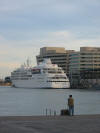 |
|
As
we walked back to our ship for our last night (in port in Barcelona), we
took the opportunity to snap a quick shot. |